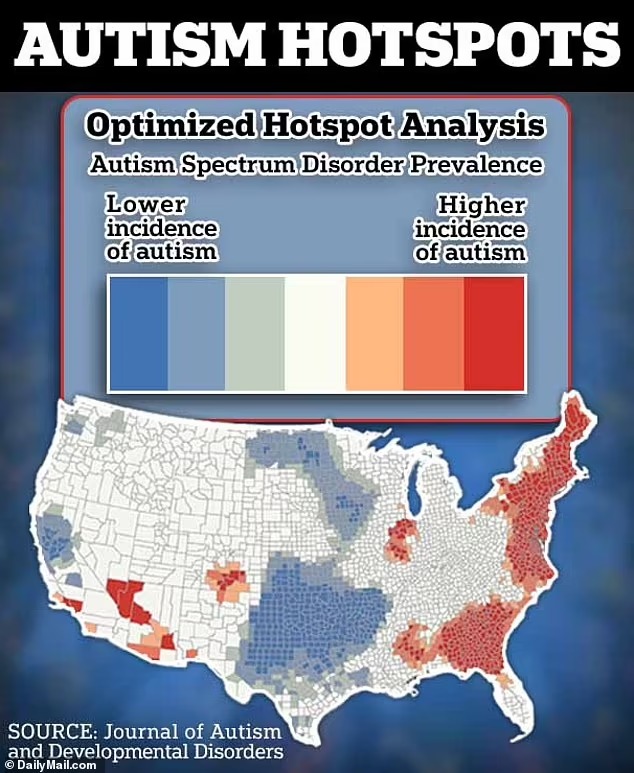A recent map highlighting “hotspots” for autism prevalence across the United States has raised questions about why certain regions stand out in red—indicating higher rates of autism spectrum disorder (ASD). While multiple factors likely contribute to any geographic differences, one possibility that’s too often overlooked is prolonged, high-level exposure to radiofrequency radiation (RFR), or microwave radiation.

1. Understanding the Hotspots
The red areas on the map aren’t just random pockets of autism diagnoses; they frequently coincide with regions known for extensive wireless infrastructure or military/defense installations. Examples include:
- Radar and Defense Installations: In the 1980s, certain military air traffic commands relocated to Georgia and other Southern states, bringing advanced radar and communications systems. These systems can emit powerful, long-range microwave signals.
- Early Wireless Adoption: Coastal urban centers and heavily industrialized corridors often embraced cellular and wireless broadband earlier, leading to a denser array of cell towers and higher cumulative EMF exposure over time.
Why It Matters:
Chronic RFR exposure—from radar, military communications, or commercial wireless networks—introduces what some call “entropic waste” into the environment. Studies suggest that non-thermal effects of microwave radiation may influence neurodevelopment, potentially compounding other risk factors for autism.
2. Section 704 of the Telecommunications Act: A Barrier to Local Control
What magnifies this concern is Section 704 of the Telecommunications Act of 1996, a federal law that prevents local communities from rejecting cell tower placements on the basis of health concerns. Even as evidence accumulates that regions with high RFR exposure may see upticks in autism (among other conditions), local governments remain legally bound to ignore these potential health effects when approving new towers.
Implication:
Without the ability to regulate EMF emissions based on emerging science, communities in red “hotspot” areas—and soon many others—may be forced to accept even denser wireless infrastructure. Over time, that could shift the entire map further into the red if RFR exposure does, in fact, play a role in autism prevalence.
3. A Longer History of Microwave Use
Military radars and advanced communication systems have existed for decades, especially around major bases and strategic installations. These technologies typically run on high-powered microwave frequencies to detect aircraft or transmit data over vast distances.
- High Exposure Over Time: Neighborhoods near major defense or aerospace hubs, which may have been under radar sweeps or intense microwave transmissions since the 1980s or earlier, offer an example of sustained EMF exposure.
- Civilian Wireless Boom: In the 1990s and 2000s, commercial wireless carriers rapidly expanded, sometimes piggybacking on existing military or industrial towers. This further increased local RFR levels in areas already saturated with high-powered signals.
4. Why Non-Thermal Effects Matter
Historically, EMF safety standards focus on thermal (heating) effects. Yet modern research highlights non-thermal biological impacts—like oxidative stress, hormone disruption, and voltage-gated calcium channel (VGCC) activation—that may contribute to neurological and developmental issues:
- Autism Risk: If these non-thermal mechanisms distort the signals critical for brain development, it could help explain regional spikes in autism diagnoses.
- Cumulative Exposures: Decades of radar plus the addition of commercial wireless can result in a persistent, high-level “background” environment of microwave signals.
5. Restoring Local Rights to Address Emerging Science
While no single factor—EMFs or otherwise—can fully explain autism hotspots, the potential influence of RFR can’t be dismissed. Local communities need the power to respond to modern science, yet Section 704 blocks that authority. Updating the law would:
- Permit Health-Based Decisions: Let municipalities factor in non-thermal EMF risks when approving or rejecting towers.
- Encourage Safer Tech: Push industry toward solutions—like space-based wireless or lower-power networks—that reduce ground-level exposures.
- Align With Modern Research: Move beyond the outdated thermal-only model and adopt standards that acknowledge subtle biological effects.
6. Conclusion
The red “hotspots” on the autism prevalence map align uncomfortably well with areas that have long histories of microwave radiation exposure, whether from military radar or commercial wireless infrastructure. As we consider how best to protect future generations, it’s crucial to recognize that local governments remain hamstrung by Section 704—a federal law that mandates adherence to outdated guidelines and stifles health-based community action.
If we fail to address this legislative barrier and continue expanding wireless networks under antiquated assumptions, more regions could shift from blue to red on the autism map. By reforming Section 704, empowering local decision-makers, and updating EMF safety standards to include non-thermal effects, we can better guard against the silent, invisible forces that may be reshaping our children’s developmental outcomes.